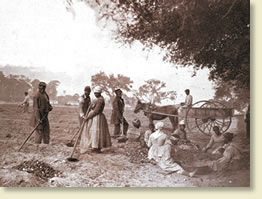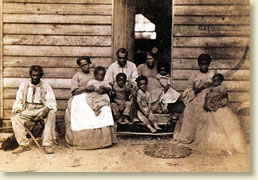|
Life on a Southern Plantation, 1854
The moral inconsistency of slavery existing within a nation founded upon the sanctity of individual freedom was well recognized in the early days of America's history. All 13 colonies legalized slavery at the beginning of America's War of Independence in 1775. By the time the nation's Constitution was ratified 13 years later; five states had abolished the practice.
 |
A Southern Plantation
from a contemporary illustration |
In the late 18th century the slaves of the South fueled an economic engine based on tobacco. After years of over-planting and subsequent depletion of the soil's nutrients, the tobacco fields were becoming less productive and less profitable. Many (including Thomas Jefferson) thought that, as a consequence, slavery would waste away and become extinct.
Eli Whitney (a Northerner) changed all this in 1792 when he invented the cotton gin. The problem this new machine addressed was the inherent difficulty in separating the lint of a cotton plant from its seed. It took a slave an average of 10 tedious hours to produce one pound of clean cotton. Whitney's inspiration was to construct an "engine" that mechanically separated seed from lint by turning a crank. With it, a slave could produce up to 1,000 pounds of cotton per day. By 1850, the South was exporting over one million tons of cotton annually to the hungry textile mills of England. Cotton was king in the South and its increased labor demands invigorated the institution of slavery. By the beginning of the Civil War over 3 million slaves tilled the South's soil.
As cotton gained economic supremacy in the South, the North was transforming itself into an urbanized, industrial society with economic interests at variance with those of the South. Slavery became a passionate focal point of contention, ferociously attacked or defended.
It was in this atmosphere that writer Frederick Olmsted made a number of trips through the South in the 1850s publishing his observations in the New York Daily Times (soon to become the New York Times) and later as three books. Although Olmsted abhorred slavery, his accounts were objective and accepted by most Southern critics as accurate depictions of plantation life.
We join Olmsted's account as he accompanies an overseer on a tour of a large, prosperous plantation in Mississippi:
"The plows at work, both with single and double mule teams, were generally held by women, and very well held, too. I watched with some interest for any indication that their sex unfitted them for the occupation. Twenty of them were plowing together, with double teams and heavy plows. They were superintended by a Negro man who carried a whip, which he frequently cracked at them, permitting no dawdling or delay at the turning; and they twitched their plows around on the head-land, jerking their reins, and yelling to their mules, with apparent ease, energy, and rapidity.
Throughout the Southwest the Negroes, as a rule, appeared to be worked much harder than in the Eastern and Northern Slave States... They are constantly and steadily driven up to their work, and the stupid, plodding, machine-like manner in which they labor, is painful to witness. This was especially the case with the hoe-gangs. One of them numbered nearly two hundred hands (for the force of two plantations was working together), moving across the field in parallel lines, with a considerable degree of precision. I repeatedly rode through the lines at a canter, without producing the smallest change or interruption in the dogged action of the laborers, or causing one of them, so far as I could see, to lift an eye from the ground... I think it told a more painful story than any I had ever heard, of the cruelty of slavery. It was emphasized by a tall and powerful Negro who walked to and fro in the rear of the line, frequently cracking his whip, and calling out in the surliest manner, to one and another, 'Shove your hoe, there! Shove your hoe!' But I never saw him strike anyone with the whip.
I happened to see the severest corporeal punishment of a Negro that I witnessed at the South while visiting this estate... The manner of the overseer, who inflicted the punishment, and his subsequent conversation with me about it, indicated that it was by no means unusual in severity.
 |
| Slaves in the field |
I had accidentally encountered him, and he was showing me his plantation. In going from one side of it to the other, we had twice crossed a deep gully, at the bottom of which was a thick covert of brushwood. We were crossing it a third time, and had nearly passed through the brush, when the overseer suddenly stopped his horse exclaiming, 'What's that? Hallo! Who are you, there?'
It was a girl lying at full length on the ground at the bottom of the gully, evidently intending to hide herself from us in the bushes.
'Who are you, there?'
'Sam's Sall, sir.'
'What are you skulking there for?'
The girl half rose, but gave no answer.
'Have you been here all day?'
'No, sir.'
'How did you get here?'
The girl made no reply.
'Where have you been all day?'
The answer was unintelligible.
After some further questioning, she said her father accidentally locked her in, when he went out in the morning.
'How did you manage to get out?'
'Pushed a plank off, sir, and crawled out.'
The overseer was silent for a moment, looking at the girl, and then said, 'That won't do; come out here.' The girl arose at once, and walked towards him. She was about eighteen years of age. A bunch of keys hung at her waist, which the overseer espied, and he said, 'Your father locked you in; but you have got the keys.' After a little hesitation, she replied that these were the keys of some other locks; her father had the door-key.
Whether her story was true or false, could have been ascertained in two minutes by riding on to the gang with which her father was at work, but the overseer had made up his mind.
'That won't do,' said he; 'get down.' The girl knelt on the ground; he got off his horse, and holding him with his left hand, struck her thirty or forty blows across the shoulder with his tough, flexible, 'raw-hide' whip (a terrible instrument for the purpose). They were well laid on, at arm's length, but with no appearance of angry excitement on the part of the overseer. At every stroke the girl winced and exclaimed, ''Yes, sir!' or 'Ah, sir!' or 'Please, sir!' not groaning or screaming. At length he stopped and said, 'Now tell me the truth.' The girl repeated the same story. ''You have not got enough yet,' said he; 'pull up your clothes-lie down.'
The girl without any hesitation, without a word or look of remonstrance or entreaty, drew closely all her garments under her shoulders, and lay down upon the ground with her face toward the overseer, who continued to flog her with the raw-hide, across her
 |
| Slave quarters |
naked loins and thighs, with as much strength as before. She now shrunk away from him, not rising, but writhing, groveling, and screaming, 'Oh, don't, sir! Oh, please stop, master! Please, sir! Please, sir! Oh, that's enough, master! Oh, Lord! Oh, master, master! Oh, God, master, do stop! Oh, God, master! Oh, God, master!'
A young gentleman of fifteen was with us; he had ridden in front, and now turning on his horse, looked back with an expression only of impatience at the delay. It was the first time I had ever seen a woman flogged. I had seen a man cudgeled and beaten, in the heat of passion, before, but never flogged with a hundredth part of the severity used in this case.
I glanced again at the perfectly passionless but rather grim business-like face of the overseer, and again at the young gentleman, who had turned away; if not indifferent he had evidently not the faintest sympathy with my emotion. Only my horse chafed. I gave him rein and spur and we plunged into the bushes and scrambled fiercely up the steep acclivity. The screaming yells and the whip strokes had ceased when I reached the top of the bank. Choking, sobbing, spasmodic groans only were heard. I rode on to where the road, coming diagonally up the ravine, ran out upon the cotton-field. My young companion met me there, and immediately afterward the overseer. He laughed as he joined us, and said: 'She meant to cheat me out of a day's work, and she has done it, too.' "
References:
Olmsted's account appears in: Olmsted, Frederick, Law, (Arthur M. Schlesinger ed.), The Cotton Kingdom (1953); Nevins, Allan, Ordeal of the Union (1947);
How To Cite This Article:
"Life on a Southern Plantation, 1854", EyeWitness to History, www.eyewitnesstohistory.com (2005).
|






